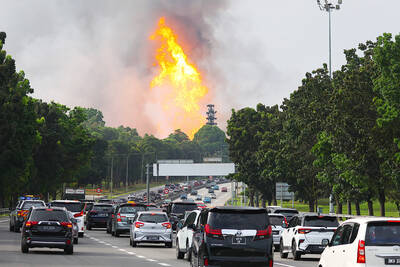China’s Three Gorges Dam has caused a host of ills that must be “urgently” addressed, the government has said, in a rare admission of problems in a project it has long praised as a world wonder.
The State Council acknowledged the environmental, social and geological problems in a statement issued late on Wednesday after a meeting on the hydroelectric project’s future presided over by Chinese Premier Wen Jiabao (溫家寶).
“While the Three Gorges project has brought great and comprehensive benefits, there are problems that must be urgently resolved in the smooth relocation of residents, ecological protection and preventing geological disasters,” it said.
The dam has also “impacted” downstream shipping, irrigation and water supplies, the statement said.
Construction began in 1993 on the US$22.5 billion dam on the Yangtze River — the world’s largest hydroelectric dam — and the project in central China began generating power in 2008.
Authorities have hailed it as a major new clean energy source and a way to tame the notoriously flood-prone Yangtze, China’s -longest river.
However, critics have long warned of its environmental, social and other costs.
About 1.4 million people were displaced to make way for the dam and its huge reservoir, which has put several cultural heritage sites deep underwater.
Chinese experts and officials have warned of the potential for seismic disturbances — including landslides and mudflows — caused by the massive weight of the reservoir’s water on the region’s geology.
Environmentalists have long cautioned that the reservoir would serve as a giant catchment for China’s notorious pollution, ruining water quality.
The government said last August that billions of US dollars would be needed to address environmental damage along the river, including sewage treatment.
The statement from the State Council said the government would step up efforts to ensure prosperous new lives for the displaced and address water pollution and geological risks, but gave no specifics of any new policies.
Torrential rains and resulting flooding in last summer washed huge quantities of trash and other debris into the river, sparking a major clean-up effort.
State media reports said the garbage was so thick in places that it could be walked on and threatened to clog the dam.
China is relying on hydroelectric power as a major component in its energy mix as it seeks to meet soaring power needs. It has dozens of dams either under construction or on the drawing board, according to state media reports.

DITCH TACTICS: Kenyan officers were on their way to rescue Haitian police stuck in a ditch suspected to have been deliberately dug by Haitian gang members A Kenyan policeman deployed in Haiti has gone missing after violent gangs attacked a group of officers on a rescue mission, a UN-backed multinational security mission said in a statement yesterday. The Kenyan officers on Tuesday were on their way to rescue Haitian police stuck in a ditch “suspected to have been deliberately dug by gangs,” the statement said, adding that “specialized teams have been deployed” to search for the missing officer. Local media outlets in Haiti reported that the officer had been killed and videos of a lifeless man clothed in Kenyan uniform were shared on social media. Gang violence has left

US Vice President J.D. Vance on Friday accused Denmark of not having done enough to protect Greenland, when he visited the strategically placed and resource-rich Danish territory coveted by US President Donald Trump. Vance made his comment during a trip to the Pituffik Space Base in northwestern Greenland, a visit viewed by Copenhagen and Nuuk as a provocation. “Our message to Denmark is very simple: You have not done a good job by the people of Greenland,” Vance told a news conference. “You have under-invested in the people of Greenland, and you have under-invested in the security architecture of this

A fire caused by a burst gas pipe yesterday spread to several homes and sent a fireball soaring into the sky outside Malaysia’s largest city, injuring more than 100 people. The towering inferno near a gas station in Putra Heights outside Kuala Lumpur was visible for kilometers and lasted for several hours. It happened during a public holiday as Muslims, who are the majority in Malaysia, celebrate the second day of Eid al-Fitr. National oil company Petronas said the fire started at one of its gas pipelines at 8:10am and the affected pipeline was later isolated. Disaster management officials said shutting the

Japan unveiled a plan on Thursday to evacuate around 120,000 residents and tourists from its southern islets near Taiwan within six days in the event of an “emergency”. The plan was put together as “the security situation surrounding our nation grows severe” and with an “emergency” in mind, the government’s crisis management office said. Exactly what that emergency might be was left unspecified in the plan but it envisages the evacuation of around 120,000 people in five Japanese islets close to Taiwan. China claims Taiwan as part of its territory and has stepped up military pressure in recent years, including